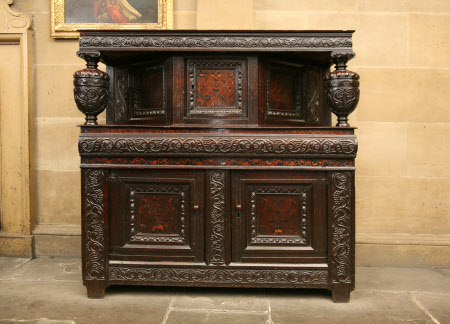Court cupboard
Category
Furniture
Date
1640 - 1660
Materials
Carved, turned and joined oak, the inlay probably stained sycamore and bog oak
Measurements
139 x 148 x 51 cm
Place of origin
Leeds, Yorkshire
Order this imageCollection
Nostell Priory, West Yorkshire
NT 959680
Summary
A rare oak and inlaid court cupboard, Leeds and the surrounding area, Yorkshire, mid-17th century. Having a leafy 'S'-scroll carved cushion-moulded frieze, raised on turned bulbous columns topped by Ionic capitals and carved with gadrooning, jeweled strapwork and scrolling foliage. The cupboard of canted form, with a central floral marquetry-inlaid boarded door with applied carved rails, flanked by conforming panels and serpent-carved ends, a leafy 'S'-scroll carved long drawer below, above a pair of conforming marquetry-inlaid panelled doors, the lower muntin rail and stile supports with meandering foliate-carved decoration. This type of cupboard, of very fine quality, is constructed in the Elizabethan-Revival manner; a style popularized in the Leeds area by a large workshop group working around the mid-17th century. It is characterized by the use of inlaid floral panels and/or bands of geometric parquetry inlay, together with the elaborate use of turnings and foliate-inspired carved decoration. This particular cupboard has the distinctive addition of rare carved serpents. Victor Chinnery illustrates two comparable examples which are 'Elizabethan' in character, described by the author as 'an archaic survival of an earlier taste'.
Full description
Once thought to have come from the 17th century house at Nostell, surviving bills and receipts suggest that much of the oak furniture at Nostell Priory was in fact purchased by Charles Winn (1795 - 1874), who inherited a house with many rooms unfinished. An interested antiquarian, Winn chose to furnish some of the rooms, such as the Lower Hall, Vestibule and West Passage, with furniture of the 16th and 17th centuries. Payments were made by Winn to E. Terry of Thornes, near Wakefield, for 'sundry pieces of antique oak furniture' in 1834 and to John Swaby, a curiosity dealer of Wardour Street, London, for 'several pieces of old carved wood' in May 1821, some of which were probably used by Winn to reconstruct parts of the interior of Wragby Church. Swaby made frequent buying trips to the Continent, and may well have supplied Winn with pieces like NT 959707, a Continental armoire, and NT 959805, a largely 16th century French cabinet in the manner of du Cerceau. Some pieces, such as NT 959709 (a chair), NT 959708 and NT 959826 (both settles), amongst others, were obviously fabricated in the 19th century, although all such pieces at Nostell do incorporate timber from genuine pieces of early furniture. Much of the oak furniture at Nostell is typically Yorkshire in style.
Provenance
Possibly purchased by Charles Winn (1795 – 1874), thence by descent and transferred from the Treasury in lieu of tax in 2007.
References
Chinnery 1979, Victor Chinnery, Oak Furniture: The British Tradition (ACC revised 2016), pp. 470 - 472, Figures 4:120 and 4:121 Westgarth 2009, M. Westgarth, 'A Biographical Register of Nineteenth Century Antique and Curiosity Dealers', Regional Furniture XXIII (2009), 1 - 205, 17, 35 - 41, 109, 131, 169 - 171, 172 & Plates 21 - 27 Raikes, 2003: S.Raikes. ““A cultivated eye for the antique”: Charles Winn and the enrichment of Nostell Priory in the nineteenth century.” Apollo 157.494 (2003): pp.3-8., 5 - 6, Figure 6
